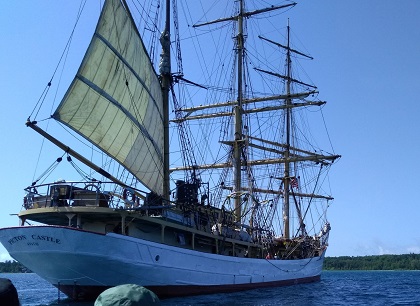
The Picton Castle is a training ship that simulates the actual conditions of a tall ship in the 1800’s, and my weeklong voyage on the ship tested me in so many ways. This was no pleasure cruise! As a trainee crew member, I experienced the exhilaration of sailing this amazing tall ship, but I also faced extraordinary challenges.
Arriving at Beaver Island
Arriving at Beaver Island was an awesome experience. All eyes were on us as we came into the harbor. Boats of all kinds began to surround us. The Pilot and Captain were on deck with their binoculars preparing to make landfall at St. James Harbor. I’ve come into many strange ports over the years, and I always have a feeling of respect, fear, and hope when entering a new port.
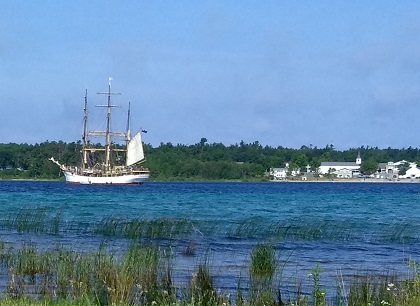
Luckily, I brought my binoculars, and I enjoyed bantering with the professionals. As we got close, a small boat came zooming out, and we could see its zigzag course showing deep water. Soon the buoys became visible, unfolding a dilemma. We had to go farther north to safely enter the harbor. It was odd steaming right toward the obvious shallow water to the buoy and turning sharply to enter St. James Harbor.
I was hoping to go to ashore with a bottle of Smooth Sailing Rum, meet some locals and learn about the local culture. The locals on Beaver Island go Boodling, which is to drive around the island at about 5 mph and drink. Unfortunately, the Picton Castle is not a cruise ship, and security watches went on through the night. Luckily, my watch was off in the early evening, and this was the perfect time for me to swing into action for a Smooth Sailing Rum photoshoot under the setting sun. It was a glorious evening.
Going Ashore at St. James Harbor
The next day the crew was divided into 2 crews: Port and Starboard. I was on the Port crew, and I had the opportunity to go to shore for 3 hours. My first stop was to a hardware store to buy a red flashlight that I could use on the ship for night vision. The town seemed to be asleep as I began to explore it, but as noon approached, it became quite lively. I returned to the ship for Lay Aloft training, one of the most challenging tall ship experiences of my week.
Meeting the Challenge of Lay Aloft Training
Captain Lorenzen began the lay aloft training with a stern talk about the seriousness of the task and how it wasn’t for everyone. To be considered for laying aloft, I had to pass a physical test of dangling from a horizontal line for 30 seconds. I went right for it first. After all, how hard could it be? It was hard, and I was tired in just 15 seconds, but I made it.
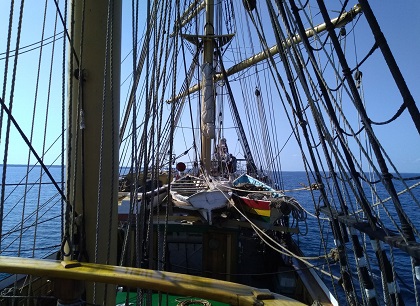
The ratlines begin about 5 feet off the deck and terminate on the mast about 5 feet below the first platform. Continuing onto the platform means traversing an inverted section. This inverted section of the ratlines is challenging because you’re climbing outbound, then reaching around the platform for an unseen handhold. As the climb continues and your head is now over the platform, you have to feel for unseen footings. A misstep or lost handhold here will likely mean a 40-foot fall to the deck. Unlike rock climbing, there are no safety lines. You only have your wits. The harness isn’t useful until you reach a work location on a yard and clip-on.
Going down was equally challenging. From the platform, I held on while feeling around with my foot for that unseen foothold, began the descent, and felt around for the next foothold. Upon reaching the deck, I was tired. Yet, those of us who completed the training were elated.
Climbing the Ratlines of the Tall Ship
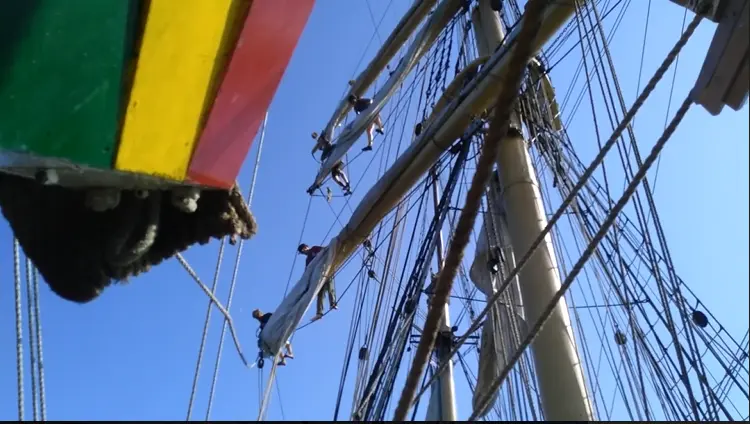
As luck would have it, the very next day was a chance to use this training in real life. We were reducing sail, and I was assigned with Hendrick to the Upper and Lower Top Sails, port side. I learned several new techniques to complete our task. Having to climb farther than the first platform, we had to step out onto a wire. It’s a 3-foot step out onto the wire, which was really scary. Once on the line, I hugged the yardarm, clipped my tether on and was frozen from fear.
Hendrick said, “I’m going to lay on.” He put a little weight on the wire so I could feel that the extra weight made the wire more taunt and made me surge upwards. He asked if I was OK, and I lied and said, “Yeah.” He said, “Laying on,” and the line surged up as I was hanging onto the yard for dear life. I hugged the yard so tight that the brackets on the yard were digging into my chest.
He said, “OK, let’s haul in the sail.” We reached down, pulled up a piece of the sail while trying to stay balanced on the wire and hanging onto the yard. We continued to pull up the sail, a couple feet at a time and layer it into the pocket on the yard. We were to continue to move down the wire, but I was fearful and unable to move much more than a few feet in either direction.
Then we wrapped a line around the sail and the yard to secure it to the yard. Hendrick moved all the way out on the yard and was doing some tasks while I was busy hanging on for dear life. Of course, he had to lay off the wire and lay back on again. These shifts in my relative position to the yard were unnerving. My legs were shaking with fatigue, my footing on the wire was strained, and my calves ached.
Hendrick said, “The lowers are done, let’s move up to the upper.” As we climbed farther up the ratlines, I shifted my weight differently, making my calves feel better. I gained confidence as I stepped out on the wire of the upper topsail.
Finally, Hendrick said we should head down. I was glad to be climbing down the ratlines and onto the deck. This was a crazy 58th birthday for me!
Experiencing the Routines of the Picton Castle
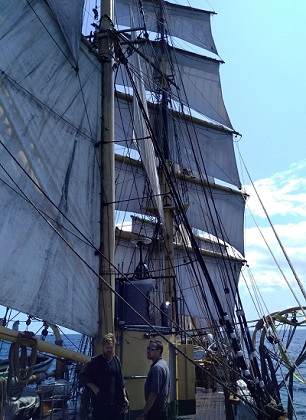
The tall ship Picton Castle is run in the traditional way. Days are an unending cycle of standing watch, working, sleeping, and eating. During my time onboard, three watches were established: Red, Blue and Green. Each watch is 4 hours on, followed by 4 hours off and sometimes a Dog Watch of 2 hours in the evening. The Dog Watch is generally easy-going, and it’s the only chance crew members have to socialize. All Hands Muster can be called at any time, and we had to be dressed and on deck soon after it is called.
Just because you are not on watch has no bearing on whether you will be called upon to work. The watches are on a rotating schedule, since all 3 watches only add up to 18 hours per day. You sleep whenever possible, and 2 or 3 hours of sleep in a day is not uncommon. A couple of days of limited sleep quickly takes its toll, and experienced crew members quickly hit the rack after a watch.
Keeping the Night Watch
The deck at night was so dark. The only light came from the navigation lights, but it was near-total darkness. Luckily, I had a couple of days of wandering around the ship and had a feel for her and where the steps and obstructions were. Still, I had to walk carefully.
I had a couple of one-hour watches at the bow. The first was on a night in the middle of the lake, with not a boat or shore to see. I was so tired. The only things to keep me awake were the hard bench I was perched on, the rain, and the cold. It was torture.
My second night at watch was on a warm, clear night. We were close to shore with quite a bit of boat traffic. The shore was lit up by cities and a myriad of red blinking lights from wind turbines. There were fishing boats, a tall ship 2 points off our Port bow, a barge coming our way, and a barge overtaking us. I made several trips to report to David, the mate, alerting him of boats in the vicinity, the direction they were traveling, and the vessel towing a barge in the distance. He was impressed with my knowledge of navigation lights.
Hoisting Up the Anchor
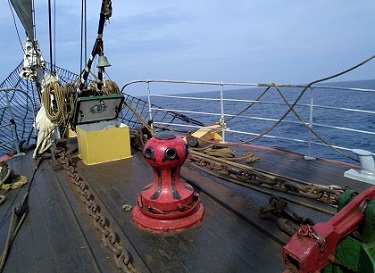
I was talking to the Captain and mentioned that I was looking forward to raising the anchor. I thought it would be fun. I have fond memories of raising anchor on my own vessels (the sorrow of leaving, the uncertainty ahead, and prospect of a new destination), but I may have forgotten how hard it was and the toll it took on me, especially in deep water. Captain Lorenzen looked me square in the eye and said, “Fun? Well, Curt, just let me know how fun it is.” I never got back to him on that.
We were in 42 feet of water and they put out a precise 3 to 1 all-chain anchor rope. That meant we had 141 feet of anchor chain deployed. The windlass was a big winch propelled by something that looks like a teeter-totter with long handles on each end. Each handle had room for four people to push down. The device is operated by 2 groups each pushing down on their side of the teeter-totter. The trick is to push down with the palm of your hand and not grip the handle. Each time a group completes a full thrust down, five inches of the chain is recovered.
We put out an extreme amount of energy pushing down, and I was fatigued. My buddy Andy stepped up and relieved me. I probably looked like I was about to die. After a couple more minutes and what seemed like 1,000 huffs and puffs, Andy began to look peaked. I relieved him, but after only another 90 seconds I again asked for Andy’s assistance. Thirty seconds after that, it was done; the anchor was back in its spot. I figure each group pushed down 169 thrusts in almost 6 minutes plus about 2 minutes with it hung up and working to free up the stoppage with the quick pumps down. The captain was correct. This was not fun.
After the anchor was stowed on the tall ship, I was told to grab a long timber and place it in a huge capstan (another winch where 3 to 6 crew members walk around to drive the winch). A secondary anchor had been readied for deployment in case the primary anchor dragged. This task was extremely difficult in the chaos of the foredeck. We needed to hop over an anchor chain twice each time around and avoid other gear. Three of us were going around so fast, jumping, jumping. I don’t know how much help I was at this point. I seemed to be giving more effort just trying to survive, using the timber to steady myself. Eventually, the line was brought in.
Answering the Dinner Bell
Shortly afterward, the Dinner Bell rang, and I was first in line. You dare not miss a meal because you’re putting out a tremendous amount of energy onboard the Picton Castle. I always awoke when I heard the meal bell, even if I only had an hour or so of sleep.
The trick is to eat fast, wash your bowl and spoon, and gather with your watch mates ready for new orders, all in 20 minutes. If you’re really quick, you may get a bathroom break, which is trickier than you think. There are only four heads on board, one for the Captain and one for the senior staff, leaving only 2 for 40-plus of us. One of those 2 actually had a shower.
Entering the Port of Sarnia
The call to Muster on deck was given when I was sleeping, just off a late-night watch. It was cold and windy. The wind was again blowing right off our bow. Crews were scampering all over the deck on little projects to prepare for the Port of Sarnia. Luckily, my watch wasn’t given orders, since I wasn’t really sure where I was from lack of sleep. I even contemplated abandoning ship when we got to port. The thought of getting a warm hotel room, a whole night’s sleep in a real bed, and some good food were tempting. A steak and a long, hot shower seemed to be powerful motivators. I resisted the temptation and stayed on board.
Sailing Aboard the Tall Ship Appledore IV
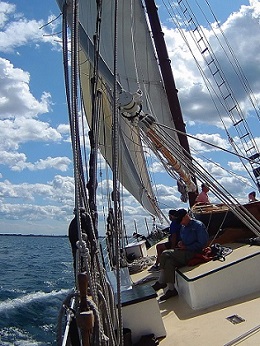
Once we were tied up and secured, the Captain Lorenzen told us we had been invited for a day sail aboard the tall ship Appledore IV. The Appledore’s big sails proved difficult to get up, even with the heft of the seasoned sailors from the Picton Castle, but we were successful. It was such a beautiful sail into Lake Huron. Now, this was my kind of boat. She was a sloop, and she was fast. The Picton Castle’s professional crew was giddy, like children at Christmas.
Steering the Picton Castle
I’m the type of sailor who sets the autopilot first then sets the sails and attends to crew comfort. I create drinks and eats while underway, while keeping an eye on our heading and tweaking the sails. For this reason, I knew that sailing on the Picton Castle would be challenging as there is no autopilot and someone is always manning the wheel when she is underway.
Every day I had an hour of instruction on the wheel. It was incredibly difficult. I was consistently told to watch the horizon, not the compass. The horizon was void of any land or reference point, so the idea of watching the seas seemed ludicrous.
I spent many free-time hours standing near the wheel trying to get a feel for what it looks like when the ship is turning. After the third time at the wheel, I was very discouraged. On my fourth and final lesson at night, I finally got it and was actually steering her by the stars.
Turning the Picton Castle
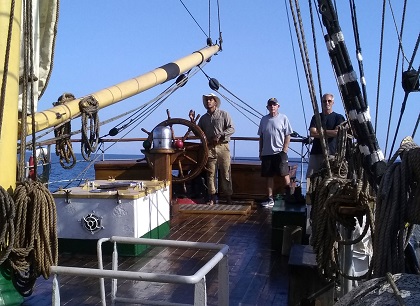
Turning the tall ship Picton Castle takes time. After a small adjustment, it takes 30 to 90 seconds to come back to the course. Sometimes the correction doesn’t work and adds more correction after a couple of minutes, which is frustrating. Large adjustments may overshoot your course and you are off course the other way.
When the mate gives an order to change course, he comes out of the chart house and tells you the new heading. Sometimes a new heading is given because you are consistently steering off course. Making it back to the Rhum line could be followed by another visit by the mate. Either way, a visit from the mate is a bad sign meaning the boat has been consistently off course.
Course is not given in degrees, but rather compass Boxing points: North by East, quarter-point North is a heading of about 8 degrees. Yes, it seems overly complicated, especially when you are attempting to keep her on course. When orders are given, the orders need to be repeated back to signify that you understand the command. This was extremely difficult, trying to comprehend what the command was and then parrot it back in what is akin to a foreign language. There is always so much to think about, and I was reminded again that this was no pleasure cruise.
Finally, Graduation Day!
As the week drew to a close, the 40 of us trainees were eager to depart. The lack of sleep, physical exertion, and small meals took a toll on me. I looked like an old man after just a week. Thankfully, I quickly recovered after a couple of good nights’ rest and big meals.
At our graduation ceremony, I thanked the Captain and crew for the excellent educational experience. The crew was very good at its job. In one short week, I had learned and experienced so much. I had sailed into new harbors, faced new challenges, and tested my limits. I departed with my certificate for crewing on the tall ship, plus memories of life as a 1800’s sailor.
